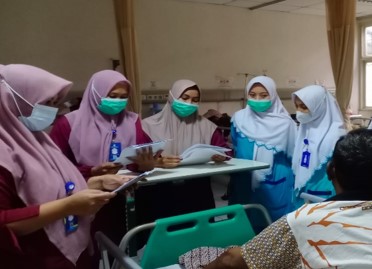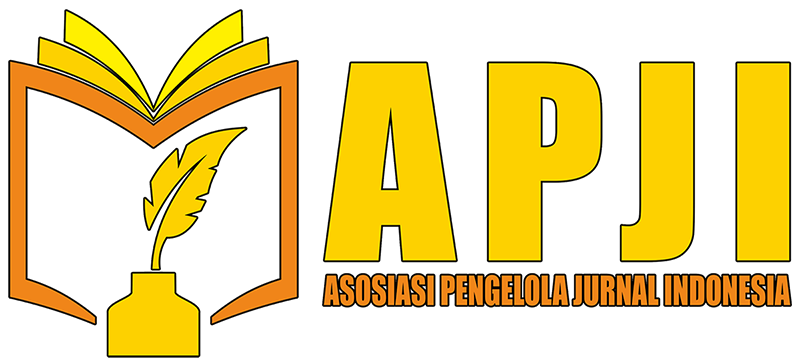Optimalisasi Handover Keperawatan di Ruang Rawat Inap Rumah Sakit Banda Aceh
Abstract
Nursing handover is the process of transferring responsibility and accountability among nurses in the provision of patient care in hospitals. Effective handover can reduce incident rates and improve patient safety. This study aimed to optimize nursing handover practices in inpatient wards. The method involved three stages: preparation (identifying issues and planning solutions), implementation (socializing handover procedures during shift changes, guiding the use of digital handover observation forms), and evaluation (assessing handover effectiveness). After the intervention, 88% of nursing handovers in the inpatient ward were carried out properly. It is concluded that regular socialization, strengthened supervision by head nurse or team leaders, reinforced team commitment, and balanced staffing considering education, work experience, and career level (Clinical Nurse I, II, and III) are necessary to sustain effective nursing handovers.
Downloads
References
A. Kullberg, L. Sharp, O. Dahl, Y. Brandberg, and M. Bergenmar. (2018). Nurse perceptions of person-centered handovers in the oncological inpatient setting: a qualitative study. International Journal of Nursing Studies, vol. 86, pp. 44–51. DOI: 10.1016/j.ijnurstu.2018.06.001
A. Hada, L. Jack, and F. Coyer. (2019). Using a knowledge translation framework to identify barriers and supports to efective nursing handover: a focus group study. Heliyon, vol. 5, no. 6. DOI: 10.1016/j.heliyon.2019.e01960
Braaf S, Rixon S, Williams A, Liew D, Manias E .(2015). Medication communication during handover interactions in specialty practice settings. J Clin Nurs. 24:19–20. DOI: 10.1111/jocn.12894
Chung JYS, Li WHC, Cheung AT, Ho LLK, Chung JOK. (2022). Efficacy of a blended learning programme in enhancing the communication skill competence and self-efficacy of nursing students in conducting clinical handovers: a randomised controlled trial. BMC Med Educ.22(1):275. https://doi.org/10.1186/s12909-022-03361-3
Chung JYS, Li WHC, Ho LLK, Cheung AT, Chung JOK. Newly graduate nurse perception and experience of clinical handover. Nurse Educ Today. 2021;97:104693. https://doi.org/10.1016/j.nedt.2020.104693
Cho S, Lee JL, Kim KS, Kim EM. (2022). Systematic Review of Quality Improvement Projects Related to Intershift Nursing Handover. J Nurs Care Qual. 37(1):E8–E14. DOI: 10.1097/NCQ.0000000000000576
Clari, M., Conti, A., Chiarini, D., Martin, B., Dimonte, V., & Campagna, S. (2021). Barriers to and facilitators of bedside nursing handover: A systematic review and meta-synthesis. Journal of Nursing Care Quality, 36(4), E51–e58. https://doi.org/10.1097/ncq.0000000000000564
CRICO Strategies, Malpractice Risks in Communication Failures, CRICO Benchmarking Report. 2015. [Online]. Available: https://psnet.ahrq.gov/issue/malpractice-risks-communication-failures-2015-annual-benchmarking-report.
Desmedt M, Ulenaers D, Grosemans J, Hellings J, Bergs J. (2021). Clinical handover and handoff in healthcare: a systematic review of systematic reviews. Int J Qual Health Care. 33(1):4. https://doi.org/10.1093/intqhc/mzaa170
F. Dellafiore, C. Arrigoni, A. M. Grugnetti et al. (2019). Bedside nursing handover and organisational will to achieve personalisation within an Italian Cardiac SurgeryUnit: the nurses’ viewpoint through a qualitative study. Professioni Infermieristiche, vol. 72, no. 1, pp. 51–59. DOI: 10.7429/pi.2019.721051
G. Lupieri, C. Creatti, and A. Palese. (2016). Cardio-thoracic surgical patients’ experience on bedside nursing handovers: fndings from a qualitative study. Intensive and Critical Care Nursing, vol. 35, pp. 28–37. DOI: 10.1016/j.iccn.2015.12.001
Kim EJ, Seomun G.(2020). Handover in Nursing: A Concept Analysis. Res Theory Nurs Pract. 34(4):297–320. DOI: 10.1891/RTNP-D-19-00089
Müller M, Jürgens J, Redaèlli M, Klingberg K, Hautz WE, Stock S. (2018). Impact of the communication and patient hand-off tool SBAR on patient safety: a systematic review. BMJ Open. 8(8). DOI: 10.1136/bmjopen-2018-022202
Kementerian Pendayagunaan Aparatur Negara Dan Reformasi Birokrasi Republik Indonesia. (2017). Peraturan Menteri Pendayagunaan Aparatur Negara Dan Reformasi Birokrasi Republik Indonesia Nomor 14 Tahun 2017 Tentang Pedoman Penyusunan Survei Kepuasan Masyarakat Unit Penyelenggara Pelayanan Publik. Diakses pada laman file:///C:/Users/admin/Downloads/PERMENPAN%20NOMOR%2014%20TAHUN%202017.pdf
Pitchforth E, Nolte E, Corbett J, Miani C, Winpenny E, van Teijlingen E. (2017). Community hospitals and their services in the NHS: identifying transferable learning from international developments–scoping review, systematic review, country reports and case studies. Health Service Delivery and Research, 5(19). DOI: 10.3310/hsdr05190
Pun J. (2021). Factors associated with nurses’ perceptions, their communication skills and the quality of clinical handover in the Hong Kong context. BMC Nurs. 20(1):95. OI: 10.1186/s12912-021-00624-0
Raeisi A, Rarani MA, Soltani F. (2019). Challenges of patient handover process in healthcare services: A systematic review. J Educ Health Promot. 30(8):173. DOI: 10.4103/jehp.jehp_460_18
Winpenny EM, Corbett J, Miani C, King S, Pitchforth E, Ling T, van Teijlingen E, Nolte E. (2016). Community Hospitals in Selected High Income Countries: A Scoping Review of Approaches and Models. Int J Integr Care. 2016;16(4):13. DOI: 10.5334/ijic.2463

Copyright (c) 2025 rachmah

This work is licensed under a Creative Commons Attribution-NonCommercial-NoDerivatives 4.0 International License.
Copyright Notice
Pernyataan Hak Cipta dan Lisensi
Dengan mengirimkan manuskrip ke Jurnal Pengabdian Masyarakat Cendikia Jenius, penulis setuju dengan kebijakan ini. Tidak diperlukan persetujuan dokumen khusus.
Hak Cipta :
Lisensi Creative Commons Atribusi-NonKomersial-BerbagiSerupa 4.0 Internasional
Hak cipta atas artikel apa pun di Jurnal Pengabdian Masyarakat Cendikia Jenius dipegang penuh oleh penulisnya di bawah lisensi Creative Commons CC BY-NC-SA 4.0.
- Hak cipta pada setiap artikel adalah milik penulis.
- Penulis mempertahankan semua hak mereka atas karya yang diterbitkan, tak terbatas pada hak-hak yang diatur dalam laman ini.
- Penulis mengakui bahwa Jurnal Pengabdian Masyarakat Cendikia Jenius sebagai yang pertama kali mempublikasikan dengan lisensi Creative Commons Atribusi 4.0 Internasional (CC BY-NC-SA-4.0).
- Penulis dapat memasukan tulisan secara terpisah, mengatur distribusi non-ekskulif dari naskah yang telah terbit di jurnal ini kedalam versi yang lain (misal: dikirim ke respository institusi penulis, publikasi kedalam buku, dll), dengan mengakui bahwa naskah telah terbit pertama kali pada Jurnal Pengabdian Masyarakat Cendikia Jenius.
- Penulis menjamin bahwa artikel asli, ditulis oleh penulis yang disebutkan, belum pernah dipublikasikan sebelumnya, tidak mengandung pernyataan yang melanggar hukum, tidak melanggar hak orang lain, tunduk pada hak cipta yang secara eksklusif dipegang oleh penulis.
- Jika artikel dipersiapkan bersama oleh lebih dari satu penulis, setiap penulis yang mengirimkan naskah menjamin bahwa dia telah diberi wewenang oleh semua penulis bersama untuk menyetujui hak cipta dan pemberitahuan lisensi (perjanjian) atas nama mereka, dan setuju untuk memberi tahu rekan penulis persyaratan kebijakan ini. Jurnal Pengbadian Masyarakat Cendikia Jenius tidak akan dimintai pertanggungjawaban atas apa pun yang mungkin timbul karena perselisihan internal penulis.
Lisensi :
Jurnal Pengabdian Masyarakat Cendikia Jenius diterbitkan berdasarkan ketentuan Lisensi Creative Commons Atribusi-NonKomersial-BerbagiSerupa 4.0 Internasional (CC BY-NC-SA 4.0). Lisensi ini mengizinkan setiap orang untuk :
Menyalin dan menyebarluaskan kembali materi ini dalam bentuk atau format apapun serta menggubah, memperbaiki, dan membuat ciptaan turunan, bahkan untuk kepentingan komersial, selama mereka mencantumkan kredit kepada Penulis atas ciptaan asli.
























